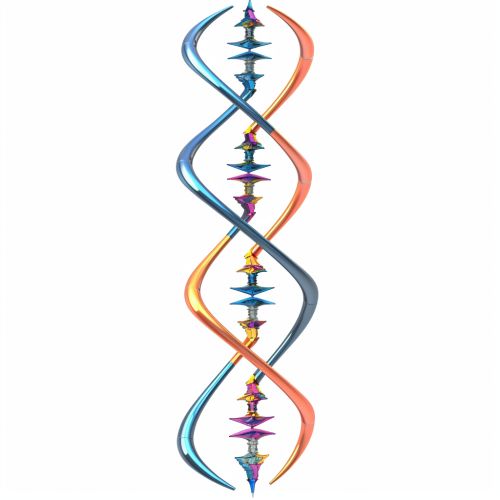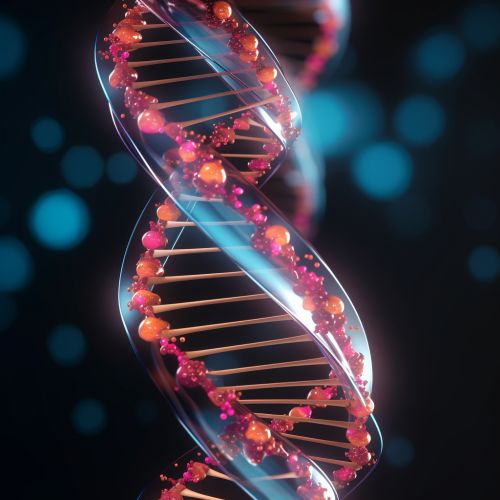DNA Replication Fork
Introduction
DNA replication fork is a crucial structure in the process of DNA replication. It is the site where the parental DNA molecule is separated into two strands, which then serve as templates for the synthesis of new DNA strands. The replication fork is a dynamic structure that moves along the DNA molecule during replication, unwinding the double helix and enabling the replication machinery to access the genetic information encoded in the DNA 1.


Structure and Formation
The formation of the DNA replication fork is initiated by the binding of the replication initiation complex to the origin of replication, a specific sequence of DNA that serves as the starting point for replication. This complex includes several proteins, including the DNA helicase, which unwinds the double helix and separates the two DNA strands to form the replication fork 2.
The replication fork is a Y-shaped structure, with the stem of the Y representing the parental DNA molecule and the arms of the Y representing the two new DNA strands being synthesized. The point where the two arms meet, where the parental DNA is being unwound and separated, is known as the fork junction 3.


Dynamics of the Replication Fork
The replication fork is a highly dynamic structure that moves along the DNA molecule during replication. The rate at which the fork moves is determined by the activity of the DNA helicase, which unwinds the DNA, and the DNA polymerase, which synthesizes the new DNA strands. The coordination of these two activities is crucial for the efficient and accurate replication of the DNA 4.
The movement of the replication fork is not always smooth and uninterrupted. There are many factors that can cause the fork to stall or pause, including DNA damage, secondary structures in the DNA, and conflicts with the transcription machinery. When the replication fork stalls, it can lead to the formation of DNA double-strand breaks, which can cause genomic instability and lead to diseases such as cancer 5.


Replication Fork Stability and Repair
The stability of the replication fork is crucial for the maintenance of genomic integrity. When the replication fork stalls or collapses, it can lead to the formation of DNA double-strand breaks, which can cause genomic instability and lead to diseases such as cancer. Therefore, cells have developed several mechanisms to stabilize the replication fork and repair any damage that occurs during replication 6.
One of these mechanisms is the DNA damage response (DDR), which is activated when the replication fork encounters a DNA lesion. The DDR involves the recruitment of various proteins to the site of the lesion, which work together to repair the damage and restart the stalled replication fork 7.
Another mechanism is the process of fork reversal, in which the replication fork is converted into a four-way junction. This allows the replication machinery to bypass the DNA lesion and resume replication on the other side. Fork reversal is a complex process that requires the activity of several proteins, including the DNA helicase and the DNA topoisomerase 8.


Conclusion
The DNA replication fork is a crucial structure in the process of DNA replication. It is the site where the parental DNA molecule is separated into two strands, which then serve as templates for the synthesis of new DNA strands. The replication fork is a dynamic structure that moves along the DNA molecule during replication, unwinding the double helix and enabling the replication machinery to access the genetic information encoded in the DNA. The stability and repair of the replication fork are crucial for the maintenance of genomic integrity, and disruptions in these processes can lead to diseases such as cancer.
See Also
References
- Alberts B, Johnson A, Lewis J, et al. Molecular Biology of the Cell. 4th edition. New York: Garland Science; 2002. DNA Replication Mechanisms.
- Bell SP, Dutta A. DNA replication in eukaryotic cells. Annu Rev Biochem. 2002;71:333-74.
- O'Donnell M, Langston L, Stillman B. Principles and concepts of DNA replication in bacteria, archaea, and eukarya. Cold Spring Harb Perspect Biol. 2013;5:a010108.
- Leman AR, Noguchi E. The replication fork: understanding the eukaryotic replication machinery and the challenges to genome duplication. Genes (Basel). 2013;4(1):1-32.
- Zeman MK, Cimprich KA. Causes and consequences of replication stress. Nat Cell Biol. 2014;16(1):2-9.
- Branzei D, Foiani M. Maintaining genome stability at the replication fork. Nat Rev Mol Cell Biol. 2010;11(3):208-19.
- Ciccia A, Elledge SJ. The DNA damage response: making it safe to play with knives. Mol Cell. 2010;40(2):179-204.
- Neelsen KJ, Lopes M. Replication fork reversal in eukaryotes: from dead end to dynamic response. Nat Rev Mol Cell Biol. 2015;16(4):207-20.
